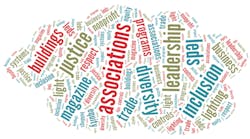Acuity Brands has announced that it achieved UL certification of a 222-nm module for safe use in occupied spaces. The product is based on the Ushio Care222 technology platform and will enable germicidal ultraviolet (GUV) functionality in a number of luminaire products from multiple of Acuity’s brands. The so-called far UV-C emission has been shown in laboratory testing to deactivate pathogens such as SARS-CoV-2 as effectively as radiation in the more typical 250–280-nm disinfection band. And proponents have claimed that the far UV-C emission would not harm human eyes and skin, whereas the longer-wavelength UV-C emissions are a proven photobiological hazard.
We first reported on the relationship between Ushio and Acuity back in June 2020. Ushio has developed a broad list of radiometric sources including lamps, lasers, and LEDs, along with subsystems and systems that use the sources in a variety of applications. The company was among the first to promote the concept that 222-nm UV-C radiation could safely deliver disinfection capability in the presence of people, and the Ushio 222-nm excimer lamp is one of few such sources available. Meanwhile, the agreement with Acuity assigned exclusive North American rights to use the Care222 module or UV-C light engine in fixtures sold for disinfection purposes.
We discussed the far-UV-C technology numerous times in the Special Reports we have published on GUV this year. The final article in that series has links to all of the content and focuses on commercial applications. We interviewed Acuity about the company’s 222-nm plans prior to the first article in the series. The company said it was prepared at the time to place the 222-nm technology into production but was waiting for an independent authority to declare it safe. Clearly, UL will serve as that authority.
UL has certified that the module meets US and Canadian standards for use in occupied spaces. That certification was evidently based on the IEC 62471:2006 standard titled “Photobiological safety of lamps and lamp systems.” “This tremendous technical achievement has come at a time when the worldwide awareness of the need to control pathogens has never been greater,” said Ron Schimmelpfenning, vice president of technology solutions at Acuity. “Substantive pathogen control in spaces while people are present can support vital activities where we work, live, and play.”
The Care222 technology is based on research from Columbia University. As mentioned earlier, the modules are based on excimer lamps. But such lamps do generate some amount of stray UV-C energy in the longer 250–280-nm band. Columbia developed a filter technology to eliminate the unsafe energy from the radiation. Meanwhile, Acuity developed a control scheme that ensures the modules do not exceed radiation levels deemed safe for occupied spaces yet do deliver dosage sufficient for deactivating pathogens.
Columbia and other research institutions have continued to document the claims of both germicidal efficacy and safety for human exposure. We have cautiously suggested more research may be needed. But clearly the preponderance of the evidence supports the safety contention. The far-UV-C photons don’t penetrate the dead skin at the outer layer of human bodies nor the tear layer of the eye.
“The certification of the Care222 module for use in lighting products in occupied spaces is the result of rigorous testing and evaluation performed by UL scientists working together with research and development teams from Acuity Brands and Ushio America, Inc. in what has become a breakthrough category in GUV product development. The certification process followed by UL included an assessment to IEC 62471 for the GUV module when installed and used according to instructions,” said Schimmelpfenning.
It appears Acuity will initially offer the module in dedicated fixtures, with control separate from the visible lighting systems although sharing the existing AC-power infrastructure. Later expect to see the technology as an integrated option in some LED-based luminaires allowing lighting systems to also deliver disinfection. Control electronics would separately drive the UV-C and visible-light sources. Acuity said it was already accepting orders for the HDM product from Healthcare Lighting and HLDM product from Holophane. The company further said that products from Gotham, Lithonia Lighting, and Mark Architectural Lighting would soon follow.
Ironically, the 222-nm announcement is the second UV-centric release from Acuity in the recent past and both involved the company conservatively withholding products from the market awaiting regulatory support. The company has an upper-air disinfection product that uses the more traditional GUV wavelengths. The company withheld the luminaire from the California market until the California Air Resources Board certified that the products did not emit ozone that is another potential human hazard.
LEDs Magazine chief editor MAURY WRIGHT is an electronics engineer turned technology journalist, who has focused specifically on the LED & Lighting industry for the past decade.
For up-to-the-minute LED and SSL updates, why not follow us on Twitter? You’ll find curated content and commentary, as well as information on industry events, webcasts, and surveys on our LinkedIn Company Page and our Facebook page.





